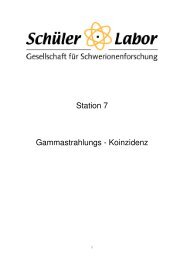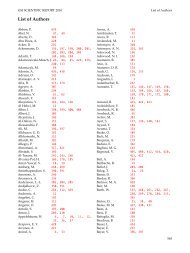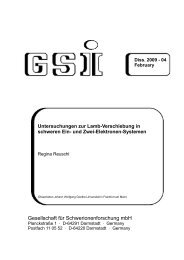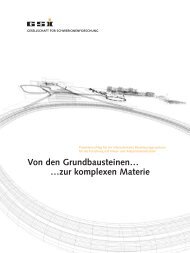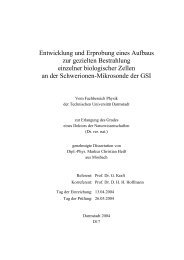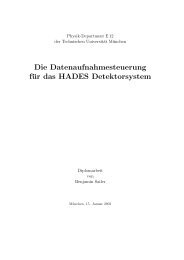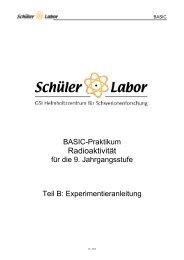CBM Progress Report 2006 - GSI
CBM Progress Report 2006 - GSI
CBM Progress Report 2006 - GSI
Create successful ePaper yourself
Turn your PDF publications into a flip-book with our unique Google optimized e-Paper software.
<strong>CBM</strong> <strong>Progress</strong> <strong>Report</strong> <strong>2006</strong> Simulations<br />
Muon detector simulations and choice of the RICH mirror shape ∗<br />
V. Baublis, A. Khanzadeev, B. Komkov, V. Nikulin, V. Samsonov, O. Tarasenkova, and E. Vznuzdaev<br />
The PNPI team in <strong>2006</strong> participated in the <strong>CBM</strong> experiment<br />
in 3 main directions: the studies of the muon system<br />
absorber layout, estimations for the feasibility of modern<br />
tracking detectors for both MuCh designs and development<br />
of the mirror-adjusting mechanics for RICH.<br />
1. The <strong>CBM</strong> muon identification system (MuCh) is supposed<br />
to be a set of absorbers interlaced with the tracking<br />
chambers. The <strong>GSI</strong> team works on the design optimized<br />
for the track-following Kalman filter procedure: a<br />
set of absorbers with subsequently increasing thickness.<br />
This design offers an optimal performance, but requires<br />
the expensive high resolution tracking detectors detectors<br />
that can work in very high hit density environment (up to<br />
∼ 1 hit per cm 2 ). Somewhat different design is proposed<br />
by the members of the PNPI team. An ideal absorber<br />
should catch all hadrons, keeping the muons intact. The<br />
absorption power of the media is characterized by the “Interaction<br />
Length” (hereafter λI) - a mean distance between<br />
the hadron interaction, while the influence of the Coulomb<br />
interaction is reflected by the value X0. In “classical” approach<br />
(NA50, NA60, ALICE...) the light-A absorbers (for<br />
example, made of carbon) are chosen because they offer<br />
the smallest value of X0 for given λI: in other words they<br />
offer the smallest multiple scattering for given nuclear absorption.<br />
The proposed MuCh layout consists of the 145 cm thick<br />
carbon absorber (3.86λI) followed by 60 cm thick iron<br />
(3.58λI). The total absorption length is the same as for<br />
the <strong>GSI</strong> option; at this thickness the ratio of the absorption<br />
powers for muons (due to the Coulomb scattering) and<br />
hadrons (due to hadron showers) reaches a plateau. Placing<br />
a thick carbon layer before iron one gives a possibility<br />
to reduce the hit density of secondary tracks in coordinate<br />
detectors. Thus the influence of the neighboring tracks is<br />
minimized.<br />
The total thickness of carbon and iron layers has been<br />
fixed, but the number of iron layers and number of detectors<br />
was varied. The GEANT3-based <strong>CBM</strong>root framework<br />
v.OKT04 was used for track transport through the detector.<br />
The background and the signal (decay muons from J/Psi<br />
and LMVM) tracks for 25 GeV Au+Au central and minimum<br />
bias events were simulated with UrQMD and Pluto<br />
generators respectively. The so-called cone method has<br />
been used for the track-finding: each STS track was considered<br />
as a muon one provided there is as minimum one<br />
hit within the multiple scattering cone around its extension<br />
in each tracking station.<br />
The analysis demonstrated that the proposed layout of<br />
absorbers (with thick first carbon layer) allows to reach a<br />
∗ Work supported in part by INTAS grant 06-1000012-8781<br />
PNPI, Gatchina, Russia<br />
23<br />
pretty high signal to background ratio. For the minimum<br />
bias events the achieved values of the efficiency and signalto-background<br />
ratio are quite close to the results of the <strong>GSI</strong><br />
team (see Figure 1). For the case of central events the performance<br />
of the muon system is obviously degrades due<br />
to high hit density in tracking stations. Additional inefficiency<br />
is inherent to the cone method;the resulting efficiency<br />
drops to the level of S/B 4 × 10 −3 .<br />
Signal/Background<br />
Graph<br />
1.2<br />
1<br />
0.8<br />
0.6<br />
0.4<br />
0.2<br />
χ 2 / ndf<br />
9.512e-06 / 1<br />
p0 1.534 ± 2.784<br />
p1 -0.02487 ± 0.1693<br />
p2 0.0001686 ± 0.002222<br />
Efficiency<br />
2<br />
χ χ 2<br />
2 / / ndf<br />
ndf 9.512e-06 0.00383 / / -2 -3<br />
p0 1.534 ± 2.784<br />
p0 -0.23 ± 1.225<br />
p1 -0.02487 ± 0.1693<br />
p1 p2 0.0001686 0.02247 ±<br />
± 0.002222 0.02981<br />
Omega Meson<br />
Signal/Background<br />
20 30 40 50 60<br />
0<br />
Iron Thickness, cm<br />
Figure 1: The signal-to-background ratio (blue line) and<br />
the selection efficiency (red curve) as a function of the<br />
number of 15 cm thick iron absorbers for the minimum bias<br />
events.<br />
2. It has been demonstrated that the existing modern<br />
position-sensitive detectors (micromegas, GEM, even the<br />
cathode pad chambers in peripheral zone) could be used in<br />
case of MuCh. Even for the hottest zones with hit density<br />
of about 1 cm −2 the gas detectors could be built. However,<br />
the significant angular distribution implies the limitation on<br />
the spatial resolution of the detectors: according to our estimations<br />
one will not be able to achieve the resolution better<br />
than 0.25 mm, most likely the best resolution will be of order<br />
∼ 0.3 mm.<br />
3. The designer team presented a conception of the design<br />
for RICH mirrors adjustment and fixation mechanics.<br />
Two prototypes were aso built: the first uses the mirror fixation<br />
at its center, in the second the mirror is fixed at 3<br />
points in its peripheral zone. The analysis of high precision<br />
measurements prove the design.<br />
9<br />
8<br />
7<br />
6<br />
5<br />
4<br />
3<br />
2<br />
1<br />
Reconstruction Efficiency



